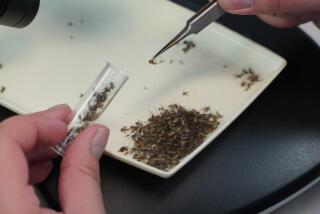INFECTIOUS-DISEASE REPORT
- Share via
Each week the Orange County Public Health Department reports to the state the incidence of various infectious diseases in the county. The following table details a selection of these afflictions for March, the most recent month for which information is available:
NUMBER OF CASES March Current Previous Disease 1989 Year to Date Year to Date Acquired Immune 32 86 78 Deficiency Syndrome (AIDS) Campylobacter 13 35 68 Lapse of consciousness 142 342 442 (non-alcohol related) Giardiasis 41 114 79 Gonococcal infection 162 541 736 Hepatitis A 55 125 98 Hepatitis B 69 136 94 Lead poisoning 13 54 218 Measles (rubeola) 57 68 0 Meningitis 19 40 48 Salmonellosis 16 54 87 Scarlet fever 17 31 31 Shigellosis 25 72 52 Streptococcal infection 346 1,175 591 Syphilis 64 185 308 Tuberculosis 17 65 29
Year to Date % Disease Change, ‘88-’89 Acquired Immune +10 Deficiency Syndrome (AIDS) Campylobacter -49 Lapse of consciousness -23 (non-alcohol related) Giardiasis +44 Gonococcal infection -26 Hepatitis A +28 Hepatitis B +45 Lead poisoning -75 Measles (rubeola) +6,800 Meningitis -17 Salmonellosis -38 Scarlet fever No change Shigellosis +38 Streptococcal infection +99 Syphilis -40 Tuberculosis +124
Acquired immune deficiency syndrome: Fatal disease that attacks the body’s immune system. Is caused by the human immunodeficiency virus. Transmitted by sexual contact, exposure to contaminated blood and from an infected mother to her newborn.
Campylobacter: Characterized by sudden, acute diarrhea, abdominal pain, fever and vomiting. Associated with foods poorly refrigerated or improperly cooked, unpasteurized milk and unchlorinated water.
Giardiasis: A protozoan infection principally of the upper small intestine. May be associated with a variety of intestinal symptoms such as chronic diarrhea, abdominal cramps and bloating, fatigue and weight loss. Contracted by ingesting contaminated food or water.
Gonococcal infections: Sexually transmitted bacterial diseases that differ in males and females in terms of course, severity and recognition.
Hepatitis A: An acute viral illness affecting the liver. Occurs mostly in children and young adults. Usually transmitted by oral ingestion of infected material or by poor sanitation.
Hepatitis B: An acute illness of the liver transmitted by exposure to contaminated needles, by administration of blood or blood products and/or oral ingestion of contaminated material.
Meningitis: Inflammation of the three membranes enveloping the brain and the spinal cord.
Salmonellosis: A bacterial disease characterized by the sudden onset of a headache, abdominal pain, diarrhea, nausea, vomiting, dehydration and fever. Contracted by eating contaminated food.
Scarlet fever: Basically a childhood infection, caused by streptococcal bacteria. Symptoms include fever, sore throat and widespread scarlet rash.
Shigellosis: Acute diarrhea acquired by person-to-person contact, through eating contaminated food or by handling contaminated objects.
Streptococcal infection: Often manifested as strep throat or scarlet fever. A sphere-shaped bacteria that grows like chains of little balls.
Syphilis: A chronic venereal disease caused by a spirochete and transmitted by sexual intercourse. The first symptom, a chancre, appears after an incubation period of 12 to 30 days and is followed by a slight fever.
Tuberculosis: A mycobacterial disease that usually affects the lungs. General symptoms include sweats, hectic fever and severe weight loss.
Sources: Orange County Public Health Department, “Reported Cases of Specified Notifiable Diseases,” for November, 1988.
“Control of Communicable Diseases In Man,” an official report of the American Public Health Assn., Abram S. Benenson, editor, 1985, 4th edition.
“Better Homes and Gardens Family Medical Guide,” Donald G. Cooley, editor, 1973, 2nd edition.
“The Bantam Medical Dictionary,” prepared by Laurence Urdang Associates Ltd., 1982.
“Stedman’s Medical Dictionary,” Williams and Wilkins Co., 1973, 22nd edition.






